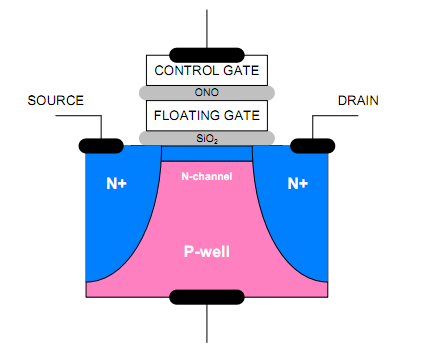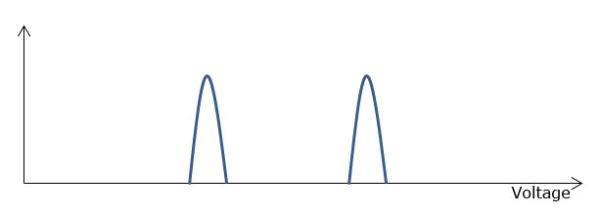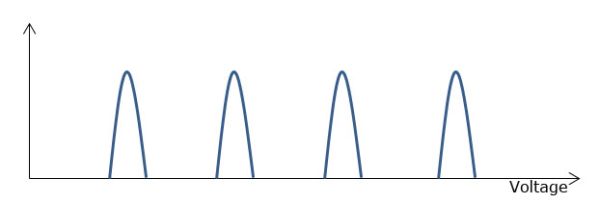Understanding TLC NAND
by Kristian Vättö on February 23, 2012 1:14 PM EST- Posted in
- Storage
- SSDs
- OCZ
- Indilinx Everest
- TLC
Weaknesses of TLC: One Degree Worse than MLC
In a perfect world, increasing the number of bits per cell sounds like a very easy way to increase capacities while keeping the prices down. So, why not put a thousand bits inside every cell? Unfortunately, there's a downside to storing more bits per cell.
Fundamentally, TLC shares the same problems as MLC when compared to SLC, but takes things one step further. Now that there are eight voltage levels to check, random reads will take more time: 100µs for TLC. That's four times longer than what it takes SLC to random read one bit, and twice as long as what it takes for MLC to complete the same task. Programming will also take longer, but unfortunately we don't have any figures for TLC yet.
| SLC | MLC | TLC | |
| Bits per Cell | 1 | 2 | 3 |
| Random Read | 25 µs | 50 µs | 100 µs |
| Erase | 2ms per block | 2ms per block | ? |
| Programming | 250 µs | 900 µs | ? |
On top of the decrease in performance, TLC also has worse endurance than MLC and SLC. Precise P/E cycle figures are not yet known, but we are most likely looking at around 1000 cycles. Hynix has a brief product sheet for their 48nm TLC flash, which has 2500 P/E cycles. At least in MLC flash, the move to 3Xnm halved the P/E cycles so we would be looking at 1250 cycles. 2Xnm brought even fewer cycles, roughly 3,000, and with same math we get 750 cycles for 2Xnm TLC. X-bit labs reported 1,000 cycles for TLC, which sounds fair. It's also good to keep in mind that endurance can vary depending on the manufacturer and maturity of the process. For example the first 25nm NANDs were good for only ~1,000 cycles, whereas today's chips should last for over 3,000 cycles.
| 5Xnm | 3Xnm | 2Xnm | |
| SLC | 100,000 |
100,000 |
N/A |
| MLC | 10,000 | 5,000 | 3,000 |
| TLC | 2,500 | 1,250 |
750 |
But why does NAND with more bits degrade quicker? The reason lies in the physics of silicon. To understand this, we need to take a look at our beloved Mr. N-channel MOSFET again.
When you program a cell, you are placing a voltage on the control gate, while source and drain regions are held at 0V. The voltage forms an electric field, which allows electrons to tunnel through the silicon oxide barrier from the N-channel to the floating gate. This process is called tunneling. The silicon oxide acts as an insulator and will not allow electrons to enter or escape the floating gate unless an electrical field is formed. To erase a cell, you apply voltage on the silicon substrate (P-well in the picture) and keep control gate voltage at zero. An electric field will be formed which allows the electrons to get through the silicon oxide barrier. This is why NAND flash needs to be erased before it can be re-programmed: you need to get rid of the old electrons (i.e. old data) before you can apply new electrons (i.e. new data).
But what does this have to do with SLC, MLC and TLC? The actual MOSFET is exactly the same in all three cases, but take a look at the table below.
| SLC | "0" | High Voltage |
| "1" | Low Voltage | |
| MLC | "00" | High Voltage |
| "01" | Med-High Voltage | |
| "10" | Med-Low Voltage | |
| "11" | Low Voltage | |
| TLC | "000" | Highest Voltage |
| "001" | High Voltage | |
| "010" | Med-High Voltage | |
| "100" | High-Medium Voltage | |
| "011" | Low-Medium Voltage | |
| "101" | Med-Low Voltage | |
| "110" | Low Voltage | |
| "111" | Lowest Voltage |
SLC only has two program states, "0" and "1". Hence either a high or low voltage is required. When the amount of bits goes up, you need more voltage stages. With MLC, there are four states, and eight states with TLC. The problem is that the silicon oxide layer is only about 10nm thick and it's not immortal; it wears out every time it's used in the tunneling process. When the silicon oxide layer wears out, the atomic bonds break and during the tunneling process, some electrons may get trapped inside the silicon oxide. This builds up negative charge in the silicon oxide, which negates some of the the control gate voltage.
At first, erasing becomes slower because higher voltages need to be applied (and for a longer time) before the right voltage is found. Higher voltage causes more stress on the oxide, wearing it out even more. Eventually, erasing will take so long that the block has to be retired to maintain the performance. There is a side effect, though. Programming will be faster because there is already some voltage in the cell due to the electron trapping. However, the time won because of that is much smaller than the time it takes to erase the cell when more voltage pulses are required to erase the cell. That's why the block has to be retired when the wear level reaches a certain point.
Here comes the differerence between SLC, MLC and TLC. The fewer bits you have per cell, the more voltage room you have. In other words, SLC can tolerate more changes in the voltage states because it has only two states. In TLC, there are eight, so the margin for errors is a lot smaller.
Lets assume that we have an SLC NAND that takes voltage between 0V and 14V. To program the cell to "1", a voltage between 4V and 5V needs to be applied. Likewise, you need a voltage from 9V to 10V to program the cell to "0". In this scenario, there is 4V of "spare" voltage between the states. If we apply this example to MLC NAND, the spare voltage will be cut to half, 2V. With TLC, that spare value is only 0.67V if we use the same 1V per voltage state ideaology.
However, when the oxide wears out and a higher voltage is needed, the programming voltages go up. To use the SLC example above, you would now need a voltage between 4V and 6V to program the cell to "0". That means a 1V loss in the spare voltage. And here comes the difference. Since SLC has more spare voltage between the states, it can tolerate a higher voltage change until the erase will be so slow that the block needs to be retired. This is why SLC has a substantially higher P/E cycle count; you can erase and reprogram the cell more times. Likewise, TLC tolerates the least change in voltage states, so it has the lowest amount of P/E cycles.














90 Comments
View All Comments
aguilpa1 - Thursday, February 23, 2012 - link
I feel all warm and technical inside.Taft12 - Thursday, February 23, 2012 - link
"However, there have been quite a few widespread firmware issues, such as SF-2281 BSOD and Intel 320 Series 8MB bugs"No list of SSD firmware cockups is complete without mentioning the Kingston V200 abysmal write performance:
http://forum.notebookreview.com/solid-state-drives...
The fact that they're handing out V+ left and right to those requesting RMAs suggests to me the problem will never get fixed.
dorion - Thursday, February 23, 2012 - link
I'm having trouble understanding why the density gain from TLC is only linear and not quadratic. It seems like the web is crawling with a bunch of articles today saying the SLC -> MLC -> TLC density gain is 16 -> 32 -> 48. It should be 16 -> 32 -> 64. Am I right? Or is there something I'm not getting? Is it part of the ECC like Gray code?Death666Angel - Thursday, February 23, 2012 - link
Huh?SLC = 1 Cell, 1 bit
MLC = 1 Cell, 2 bits
TLC = 1 Cell, 3 bits
You seem to think that TLC is 1 Cell, 4 bits, which it is not. Not sure why you would think that, though.
JarredWalton - Thursday, February 23, 2012 - link
It's simple multiples, not powers. SLC stores one bit per cell, MLC is two, and TLC is three. MLC is thus twice the capacity of SLC, but TLC is only three times the capacity, not four. The power of two increase comes in the number of states to check: SLC checks two (0/1), MLC checks four (00,01,10,11), and TLC checks eight (000, 0001..., 110, 111). If someone were to try and do QLC they would need to check sixteen states, endurance would really plummet, and performance would be worse as well.dorion - Thursday, February 23, 2012 - link
I cant believe I overlooked the difference between bits you can store and how high you can count with a certain number of bits.ionis - Friday, February 24, 2012 - link
That only proves it should go 16->32->64.1 bit - 2 states - 16 Gb
2 bits - 4 states (double the previous) - 32Gb
3 bits - 8 states (double the the previous) - should be 64Gb not 48Gb. I'm still confused how the author got 48Gb.
JMC2000 - Friday, February 24, 2012 - link
The number of bits per cell is not equal to the number of voltage states. I'm not very knowledgeable in how NAND is produced, but I think the increase in voltage states by x2 per bit may have to do with the need for differentiation to write/erase each bit.ionis - Friday, February 24, 2012 - link
The article explicitly states that the number of bits per cell is equal to the number of voltage states.JMC2000 - Friday, February 24, 2012 - link
Do you mean this paragraph?"Rather than shrinking the die to improve density/capacity, TLC (like MLC) increases the number of bits per cell. In our SSD Anthology article, Anand described how SLC and MLC flash work, and TLC works the same way but takes things a step further. Normally, you apply a voltage to a cell and keep increasing it until you reach a point where the result is far enough from the "off" state that you now consider the cell as being "on". This is how SLC works, storing one bit per cell. For MLC, you store two bits per cell, which means instead of two voltage states (0 and 1) you have four states (00, 01, 10, 11). TLC takes that a step further and stores three bits per cell, or eight voltage states (000, 001, 010, 011, 100, 101, 110, and 111). We will take a deeper look into voltage states and how they work in the next page."
Or this one?
"SLC only has two program states, "0" and "1". Hence either a high or low voltage is required. When the amount of bits goes up, you need more voltage stages. With MLC, there are four states, and eight states with TLC. The problem is that the silicon oxide layer is only about 10nm thick and it's not immortal; it wears out every time it's used in the tunneling process. When the silicon oxide layer wears out, the atomic bonds break and during the tunneling process, some electrons may get trapped inside the silicon oxide. This builds up negative charge in the silicon oxide, which negates some of the the control gate voltage."
Nowhere in the article does it state that the number of bits per transistor is equal to the number of voltage states.